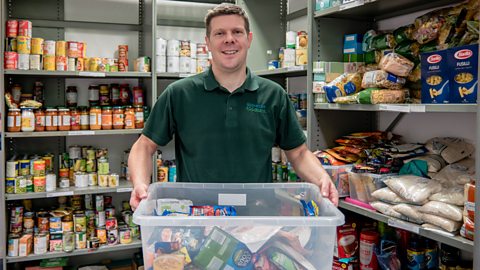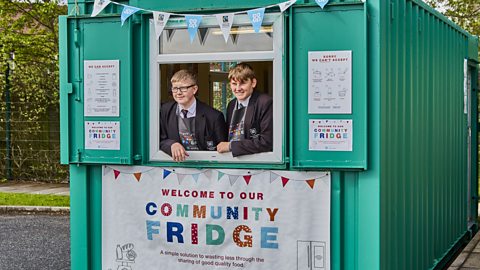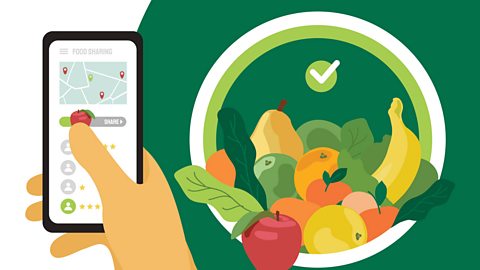Food poverty: How to seek (and give) help
From food banks to apps, organisations in the UK are providing access to food. If youŌĆÖre struggling with food insecurity or alternatively, if youŌĆÖre able to help others, hereŌĆÖs advice from the experts.

How big is the issue?
With rising energy bills and the cost of food increasing, food poverty is now a reality for many. Some are forced to choose between heating and eating, and some parents are going without food so their children can be fed.
The Food Foundation runs regular surveys in conjunction with YouGov to . In July 2021 they found 7.3 percent of UK households had experienced food insecurity in the previous month. By January 2022, the number had increased to 8.8 percent of households ŌĆō affecting approximately 4.7 million adults.
Here, four organisations explain how people can seek help and give it.
Food banks

Food banks are a well-known resource, gaining increasing attention on the front line of food poverty. However, there have been recent reports some are struggling to get the required level of donations. This is something Justin Wylie, Associate Director of Public Engagement at the ŌĆō home to more than 1,300 food banks ŌĆō is concerned about. ŌĆ£Across our network, weŌĆÖre hearing from food banks who have seen a decrease in donation levels.ŌĆØ It may be that fewer people are able to donate (and the Trussell Trust explain that more than 90 percent of the food donated comes from individuals), while more people need their services.
ŌĆ£Right now, too many families are already making impossible decisions between heating and eating, and we know that people are skipping meals, unable to afford to run cookers and fridges, and taking on debt to buy the essentials. We are deeply concerned that the cost of living crisis risks forcing many more people through the doors of food banks in the coming months, and beyond.ŌĆØ
However, Justin reassuringly explains: ŌĆ£As always, food banks in our network are committed to serving their local communities and will continue to provide everyone referred to them with emergency food and support throughout this challenging period and beyond.ŌĆØ
Before using a food bank people ordinarily require a referral, something or your can help with. ŌĆ£Once someone has been referred, they can exchange their voucher at their nearest food bank for an emergency food parcel containing a minimum of three daysŌĆÖ nutritionally balanced, non-perishable food. At most food banks in our network, a team of volunteers will also be on hand to have informal chats with people over a cup of tea to discuss their situation and also provide practical support, such as debt advice, to help people out of poverty.ŌĆØ
Want to contribute to a food bank? HereŌĆÖs how:
Food banks will have hours when people can drop-off donations, or alternatively, your local supermarket may have a collection point.
ŌĆ£Most food banks in our network do not have cold storage facilities so we generally ask people donate non-perishable, in-date food items. Small packets also tend to be easier for food banks to distribute.ŌĆØ He adds that you can also check online for up-to-date food requests. Want to go one step further? There are further volunteering options, including opportunities to be a warehouse volunteer, delivery driver or social media advocate.
Community fridges

Community fridges
Originally set up to tackle food waste, community fridges request people and businesses donate fresh food which would otherwise go to waste.
Aoife Allen is a director at , which operate 280 community fridges around the UK. They anticipate they will have 500 community fridges operating by the end of next year.
ŌĆ£A lot of the food that is shared by retailers would be fresh food that's coming towards the end of a shelf life. So, community fridges are good places to pick up fruit and veg, along with other staples that have a longer shelf life.ŌĆØ
ŌĆ£We've already seen a massive hike in the number of people using community fridges. Not just as a result of the cost of living increase but during the pandemic, when people's work was disrupted, or when people lost access to support.ŌĆØ
With no data collected or referrals necessary, Aoife explains the fridges operate on an honesty system. People can just turn up when theyŌĆÖre open but they do request people take just what they need, so thereŌĆÖs more to go round.
Accessing a community fridge is a straightforward process. Hubbub publish a so you can see if there is a location near to you. Alternatively, you could contact your local community centre and ask if they know of any.
Aoife is keen to stress people donŌĆÖt feel stigmatised when visiting a community fridge: ŌĆ£We have an ethos that they are open to everyone and that everybody is treated with dignity and respect when they visit.ŌĆØ Aoife, adds: "Community fridge coordinators are hubs of local information. Very often they'll be able to direct people to another initiativeŌĆ” It's worth always just reaching out. They can they can be great networks in addition to being a site for sharing food."
Want to contribute to a community fridge? HereŌĆÖs how:
Whether you have an allotment and have an abundance of veg your community fridge will gratefully receive them. ŌĆ£People might be able to cover staples but when it comes to those healthy items like fresh fruit and veg, they might be struggling to extend to that,ŌĆØ says Aoife.
The food needs to be fully packaged and in date or, if from your garden/allotment in good condition. Despite the "fridge" name, they will also accept tinned and packet foods.
If you have time to spare, community fridges are looking for volunteers. ŌĆ£It could just be just an hour or two a week. It might just be driving by a retailer on your way home from work and picking up a crate of food and dropping it off at a fridge.ŌĆØ If youŌĆÖd like to go one step further and are interested in setting up your own community fridge, Hubbub have guidance on .
Food sharing apps

There is a range of apps where people can give their excess food away without a centralised location, connecting directly with a person who's willing to pick it up. Tessa Clarke is co-founder and CEO of popular food-waste app .
After registering your location with the app, itŌĆÖs just a matter of searching local listings, requesting an item and arranging collection. ItŌĆÖs not just individuals who are giving items away. Supermarkets and high-street chains also use apps to give away their unsold produce.
ŌĆ£This isn't about charity. This is about community,ŌĆØ says Tessa. ŌĆ£Someone might have a head of broccoli or half a bag of potatoes and because theyŌĆÖre going away, arenŌĆÖt going to use them. And people aren't recognising this is something others would want. But half of all the food added to the app is requested in 21 minutes.ŌĆØ
ŌĆ£There will be kids who will be getting eight Easter eggs this year and there'll be other kids whoŌĆÖll not get one. We're just trying to encourage everybody to share the spare,ŌĆØ says Tessa.
Want to contribute to a food sharing app? HereŌĆÖs how:
Tessa highlights one of the main ways people can help is just to regularly go through their cupboards, fridge and freezer and give away what they wonŌĆÖt be able to use. She says it just takes 10 seconds to list an item.
However, trying to stipulate a donation is for those especially in need, while well-intentioned, may backfire: ŌĆ£Sometimes we see people putting on their listing things like ŌĆśThis is only for people who are struggling or hungryŌĆÖ and those listings don't get picked up. Because if you're having a hard time, the last thing you want to do is feel like you're being judged by someone. Just give with an open heart and just be happy that someone else is enjoying something that you weren't using.ŌĆØ
Community meals
There are a growing number of community kitchens which turn potential food waste into hot meals. Carly Shutes, works as Head of Marketing for , which hosts weekly three-course vegetarian meals in 48 locations throughout the country. ŌĆ£For lots of people it's the only day in the week theyŌĆÖll eat a hot meal and for others, the only time they'll leave the house,ŌĆØ she says.
Such is the demand, by the end of 2024 they plan to have opened 100 branches. ŌĆ£We've been seeing our numbers increase week-on-week,ŌĆØ says Carly.
Community kitchens are often run from local community centres or churches, and may not have a website. However, local Citizens Advice advisors may know whether there is one near you. Many of them, as with FoodCycle, allow people to turn up on the day with no booking required. Others are set up to deliver hot meals, such as Meals on Wheels.
ŌĆ£We know when people come once, they'll come againŌĆ” People feel quite intimidated and worried about answering questions, but there are loads of organisations that can help and who donŌĆÖt ask anything. Just don't be afraid to reach out!ŌĆØ
To find out what other services are available locally, itŌĆÖs worth visiting one event and asking the organisers what else theyŌĆÖd recommend. Carly explains: ŌĆ£People might be surprised at how much help there is, so donŌĆÖt be afraid to ask. There's tonnes of community [events] out there ŌĆō like FoodCycle. And we find that people who tend to come to our meals, generally tend to use other services too.ŌĆØ
Want to help at a community meal? HereŌĆÖs how:
Rather than food donations, FoodCycle want volunteers: to collect the food from businesses, to cook it and to host and welcome people at mealtimes.
If you would like to set up a community kitchen providing meals, youŌĆÖre going to need a venue with a kitchen and volunteers with food safety training on site. You will also need to establish a steady stream of donated food. Community kitchens can work with networks such as to get access to donations. There are organisations (such as FoodCycle) who can advise.
If you, or someone you know, have been affected by hardship, debt or homelessness, there are organisations who may be able to help with advice on accessing benefits and services.
Originally published, April 2022